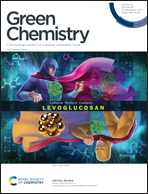γ-Valerolactone-based organic electrolyte solutions: a benign approach to polyaramid dissolution and processing†
Abstract
Polyaramids are polymers that consist of aromatic repeating units that are connected via amide bonds. From their chemical structure, an extensive intermolecular hydrogen-bond network arises, which makes them very difficult to dissolve in conventional organic solvents. A commonly used solvent system is N-methylpyrrolidone (NMP) mixed with CaCl2, where the chloride ions can break up the intermolecular hydrogen bonds. However, with NMP being a known teratogen, an alternative solvent is needed. Organic electrolyte solutions (OESs) are proposed as a green alternative solvent system. OESs are created by diluting ionic liquids (ILs) with an organic co-solvent. γ-Valerolactone (GVL) was selected as a green, renewable co-solvent. The solubility in OESs was tested for three commonly produced polyaramids: poly-p-phenylene terephthalamide (PPTA), poly-m-phenylene isophthalamide (PMIA) and copoly(p-phenylene/3,4′-diphenylether terephthalamide) (ODA/PPTA). Some OESs were excellent solvents for PMIA and ODA/PPTA, with [C8MIm][Cl]/GVL yielding solubilities as high as 23.7 wt% and 7.4 wt%, respectively, rivalling the currently used solvent systems. PPTA, on the other hand, was completely insoluble in all OESs. GVL was found to work synergistically with ILs, while acetonitrile and ethanol acted as a non-solvent and anti-solvent, respectively. OESs made from GVL and imidazolium ILs were suitable solvents for fiber spinning, as was demonstrated using a 3D-printed spinning setup. The Kamlet–Taft parameters of the OES were determined from which boundary conditions for dissolution were loosely defined as β > 0.85, α < 0.60 and π* > 0.85. A dissolution mechanism is proposed, in which the IL interacts with the polymer through hydrogen bonding via the anion, while GVL can undergo dispersion interactions with the aromatic parts of the polyaramid.



 Please wait while we load your content...
Please wait while we load your content...